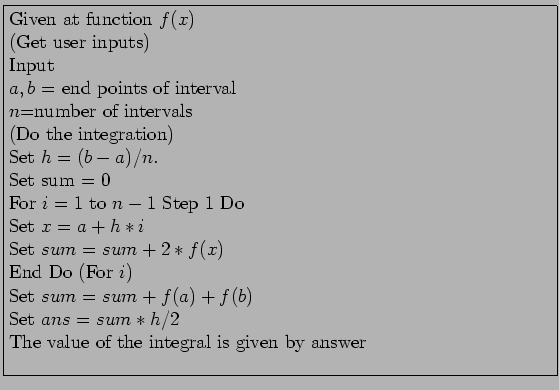The Composite Trapezoidal Rule
- If we are getting the integral of a known function over a larger span of
 -values, say, from
-values, say, from  to
to  , we subdivide [a,b] into
, we subdivide [a,b] into  smaller intervals with
smaller intervals with  , apply the rule to each subinterval, and add. This gives the composite trapezoidal rule;
, apply the rule to each subinterval, and add. This gives the composite trapezoidal rule;
The error is not the local error  but the global error, the sum of
but the global error, the sum of  local errors;
local errors;
In this equation, each of the  is somewhere within each subinterval. If
is somewhere within each subinterval. If  is continuous in [a, b], there is some point within [a,b] at which the sum of the
is continuous in [a, b], there is some point within [a,b] at which the sum of the  is equal to
is equal to  , where
, where  in [a, b]. We then see that, because
in [a, b]. We then see that, because  ,
,
An Algorithm for Integration by the Composite Trapezoidal Rule:

- Example: Given the values for
 and
and  in Table3, use the trapezoidal rule to estimate the integral
from
in Table3, use the trapezoidal rule to estimate the integral
from  to
to  . Applying the trapezoidal rule:
. Applying the trapezoidal rule:
Table 3:
Example for the trapezoidal rule.
![\begin{table}\begin{center}
\includegraphics[scale=1.1]{figures/5.4.ps}
\end{center}
\end{table}](img66.png) |
The data in Table 3 are for  and the true value is
and the true value is
 . The trapezoidal rule value is off by
. The trapezoidal rule value is off by  ; there are three digits of accuracy. How does this compare to the estimated error?
; there are three digits of accuracy. How does this compare to the estimated error?
Alternatively,
The actual error was  .
.
2004-12-21


![\begin{displaymath}
\begin{array}{rl}
\int_{1.8}^{3.4}f(x)dx& \approx \frac{0.2}...
...+ 2(20.086) + 2(24.533) + 29.964]\\
& = 23.9944\\
\end{array}\end{displaymath}](img65.png)

